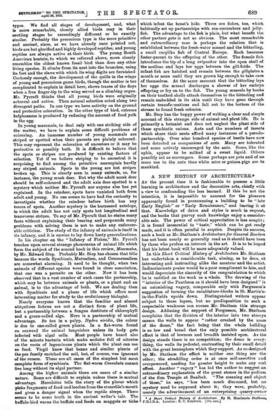A NEW HISTORY OF ARCHITECTURE.* AT the present time it
is fashionable to possess a little learning in architecture and the decorative arts, chiefly with a view to confounding the less learned. If this be not the intention, it is impossible to account for the pleasure apparently found in pronouncing a building to be "late Early English" or "Early Renaissance," and leaving it at that. Knowledge of dates and styles is much in request, and the books that purvey such knowledge enjoy a consider- able sale. The power of critical appreciation is less sought; it is found inessential to "taste," which can be got ready made, and it is often painful to acquire. Despite its success, such a book as Mr. Statham's Architecture for General .R,eaders has not been nearly so generally read as it should have been by those who profess an interest in the art. It is to be hoped that his latest book will be more adequately valued.
In this Short Critical History of Architedure Mr. Statham has undertaken a considerable task, aiming, as he does, at interesting and instructing alike the amateur and the artist. Indiscriminate praise would be a poor compliment to him, and would depreciate the sincerity of the congratulation to which he is entitled on the work as a whole. The drawing of the "interior of the Pantheon as it should have been designed" is an astonishing vagary, comparable only with Fergusson's suggestion of turning the entablature-blocks in St. Martin's- in-the-Fields upside down. Distinguished writers appear subject to these lapses, but no predisposition to such a respectable weakness can excuse Mr. Statham this strange design. Adducing the support of Ferguaaon, Mr. Statham complains that the division of the interior into two storeys causes the walls to appear "rather crushed by the mass of the dome," the fact being that the whole building is so low and broad that the only possible architectural effect is that of lowness and breadth insisted upon. As the design stands there is no competition; the dome is every- thing, the walls its pedestal, contrasting by their small detail with the great hemisphere which they support. As re-designed by Mr. Statham the effect is neither one thing nor the other; the straddling order is at once self-assertive and overpowered, needing far greater height to make any real effect. Another " vagary" has led the author to suggest an extraordinary explanation of the great stones in the podium of the Sun Temple at Baalbek. "The meaning and object of these," he says, "has been much discussed, but no mystery need be supposed about it; they were, probably, merely the advertisement of an enterprising quarry-owner
• A BAort Critical History of Arcirdectors. By H. Hes.thcote Btatimm. F.R.I.B.A. London B. T. Botsford. [10s. net.]
or contractor." It is certainly a matter of history that Sir Gilbert Scott allowed Skidmore the metal-worker to improvise ornaments upon the rood-screen in Hereford Cathedral, Skidmore promising a reduction in price if he might exhibit the finished work as a specimen of his skill. But it is surely incredible that the architect of the great temple at Baalbek should have stood any nonsense of this sort.
The general excellence of Mr. Statbam's work makes these occasional eccentricities a little disconcerting. It is hardly to be expected, however, that a "critical history" should not be in itself open to criticism. Taken as a whole, the book is astonishingly free from inaccuracy or prejudice, and as a readable text-book has a value it would be difficult to exaggerate. The continuous synopsis cut into headlines is borrowed in idea from "Sordello." It would have been more amusing had it been in rhyme, like that in Thackeray's "Rose and the Ring." We might, for example, have read : "Next came Renaissance. Inigo . . . Jones did Whitehall, and Green . . . wich Hospital is, as you know . . . A master- piece by Wren. . . . St. Paul's, of course, is his as well. . . . The dome is very clever. . . . Did I of all his buildings tell . . . I should go on for ever." With this irreverent suggestion this review shall close, but not without a sincere repetition of the felicitations that Mr. Statham has a right to expect on an arduous task well planned and thoroughly achieved. May the book run through many editions !



























































 Previous page
Previous page